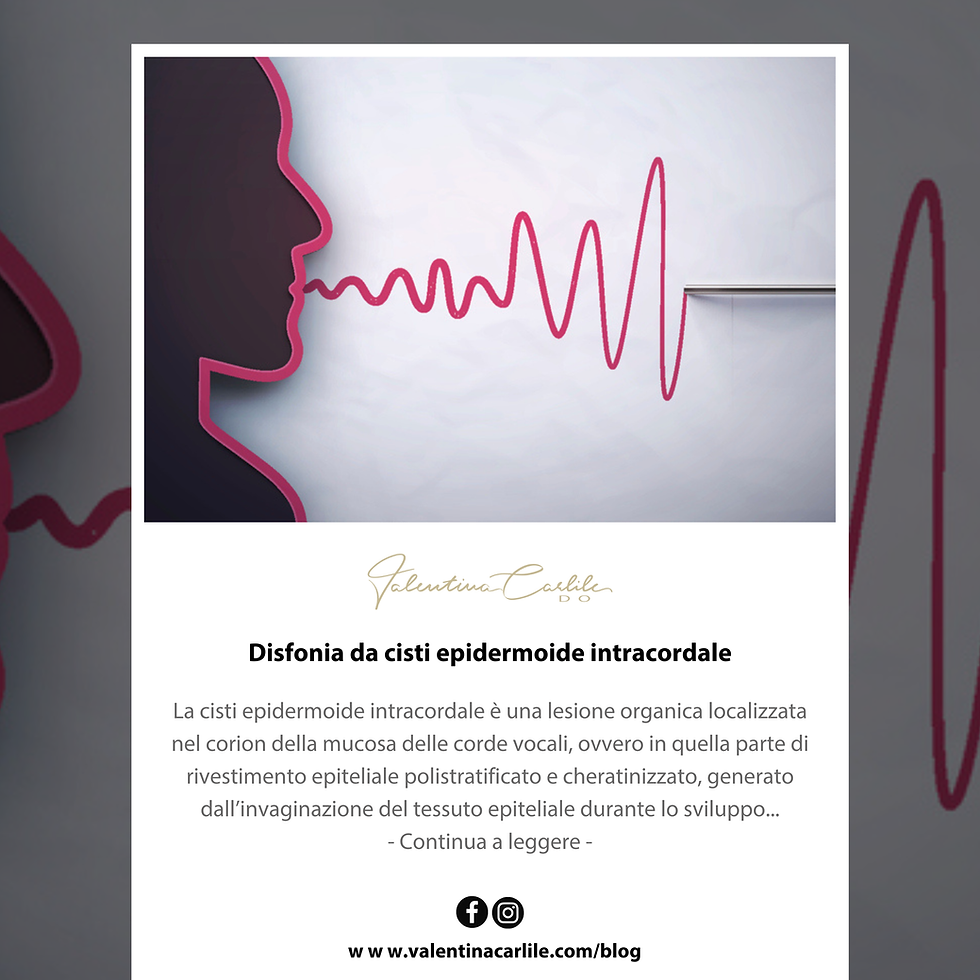Voice and Singing Osteopathy: Anatomy and structure of the vocal cords
- Valentina Carlile DO

- Jan 4, 2016
- 3 min read

The primary source of vocal production is the self-sustained oscillation of the vocal folds. The stiffness of the vocal cords determines the wave motion within the mucous layer. Thinking osteopathically in terms of structure-function, the chordal ligaments stretch from 5-15mm and their mucous membranes oscillate with an amplitude of 0.1 - 0.5mm. It is also known that in many cases vocal abuse can lead to benign or malignant pathologies.
Studies estimate that approximately 3-9% of the general population suffers from a voice-related problem at any given time. Obviously the people most at risk are voice professionals and teachers.
But when does a cord injury occur?
Well, it is believed that a cord trauma is the result of high impact efforts in which a collision occurs, a rubbing between the membranes of the vocal cords and this trauma is expressed as contact force (pressure) per collision area.
The dynamics of glottic air flow, the geometry of the vocal folds, and their biomechanical properties define some vocal parameters, including the fundamental frequency of phonation (F0).
In-depth analysis
The vocal cords are a pair of mucous structures stretched inside the larynx. Each cord has a length of 10-20mm in the antero-posterior direction, 8-12 mm in the lateral-lateral direction, and a thickness of 3-10mm.
Anatomically, three layers are identified: epithelium, lamina propria and vocal muscle.
The lamina proprio specifically is mainly composed of interstitial fluid and extracellular matrix, whose proteins regulate the bulk mechanical properties of the tissue. Among various scholars, Hirano divided the lamina in turn into three layers: superficial, medium and deep. The superficial layer includes the epithelium, which is connected to the lining area, and resists shock stress during phonation, despite including a large amount of negatively charged proteoglycans and extracellular matrix proteins. Significant organic lesions of the lamina propria rarely occur in its superficial layer.
The intermediate and deep layers, however, have a high percentage of fibrous proteins, collagen fibrils and elastin fibres.
The physical characteristics of the lamina propria vary with age. A measurement of this structure was made in males and females aged 20-50 years. The superficial and deep layers become thicker with age, while the middle layer thins. The thickness variations of the male vocal folds were greater than those of the female ones.
The superficial and intermediate layers are basically composed of extracellular matrix, while the majority of the deep and muscular layer is cellular.
The extracellular matrix is made up of proteins, lipids and carbohydrates.
Most studies have focused on the role of matrix proteins including hyaluronic acid, collagen and elastin.
Hyaluronic acid is a negatively charged glycosaminoglycan that gives the gel-like characteristic and fills the space in the matrix structure.
Collagen is a fibrous glycoprotein that is thought to provide tensile strength to tissue and plays a key role in tissue remodeling during growth and wound healing.
There are collagen types I and III in the vocal cords, collagen type III is dominant in the lamina propria, particularly in the middle and deep layers.
Other scholars have demonstrated that the average thickness and angular deviations of the collagen fibers increase as they deepen towards the thyroarytenoid muscle.
Elastin is presumed to contribute to tissue flexibility and elasticity.
It is precisely a dysfunctional organization of elastin that has been found in some vocal pathologies including benign lesions and scars.





Comments